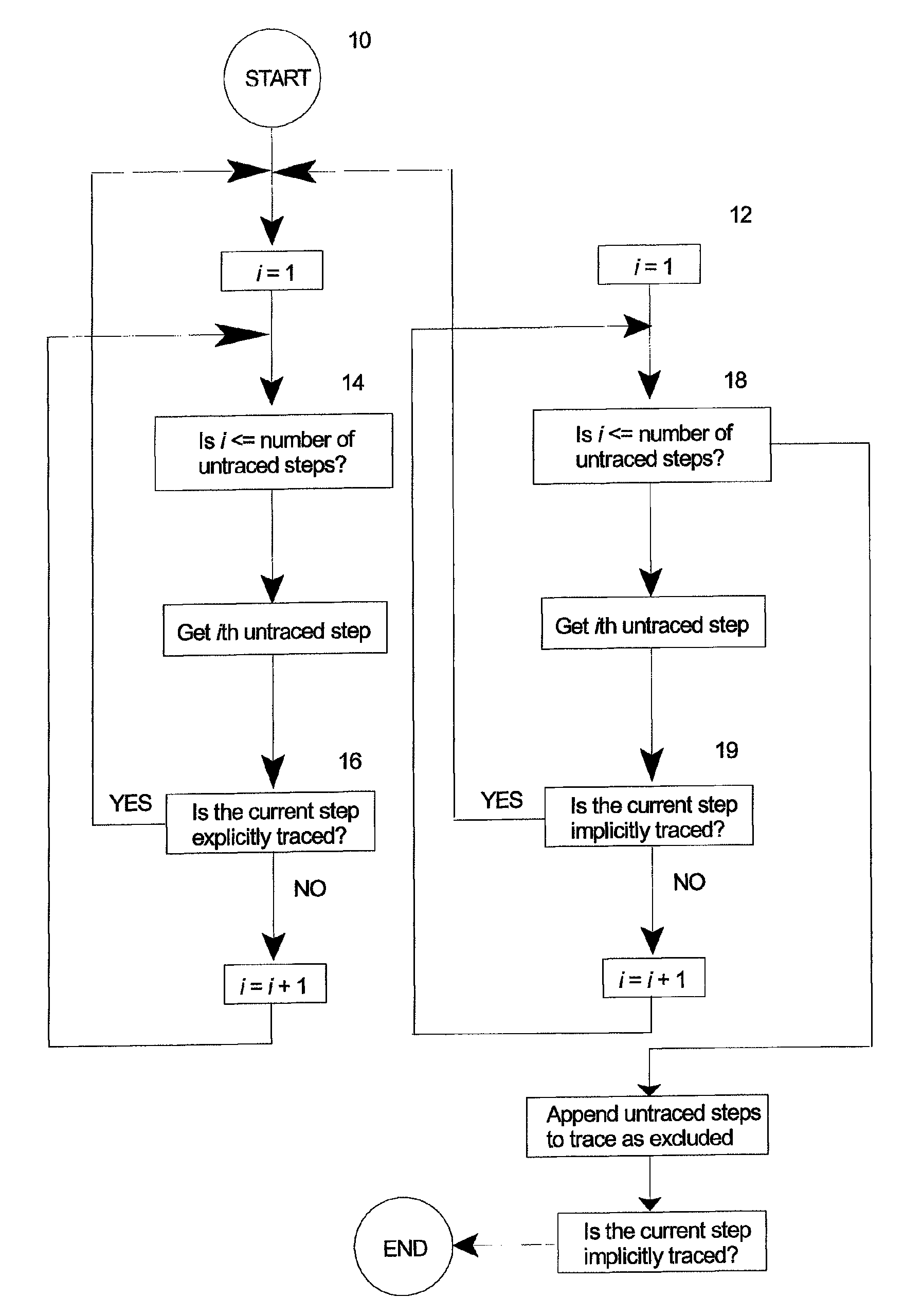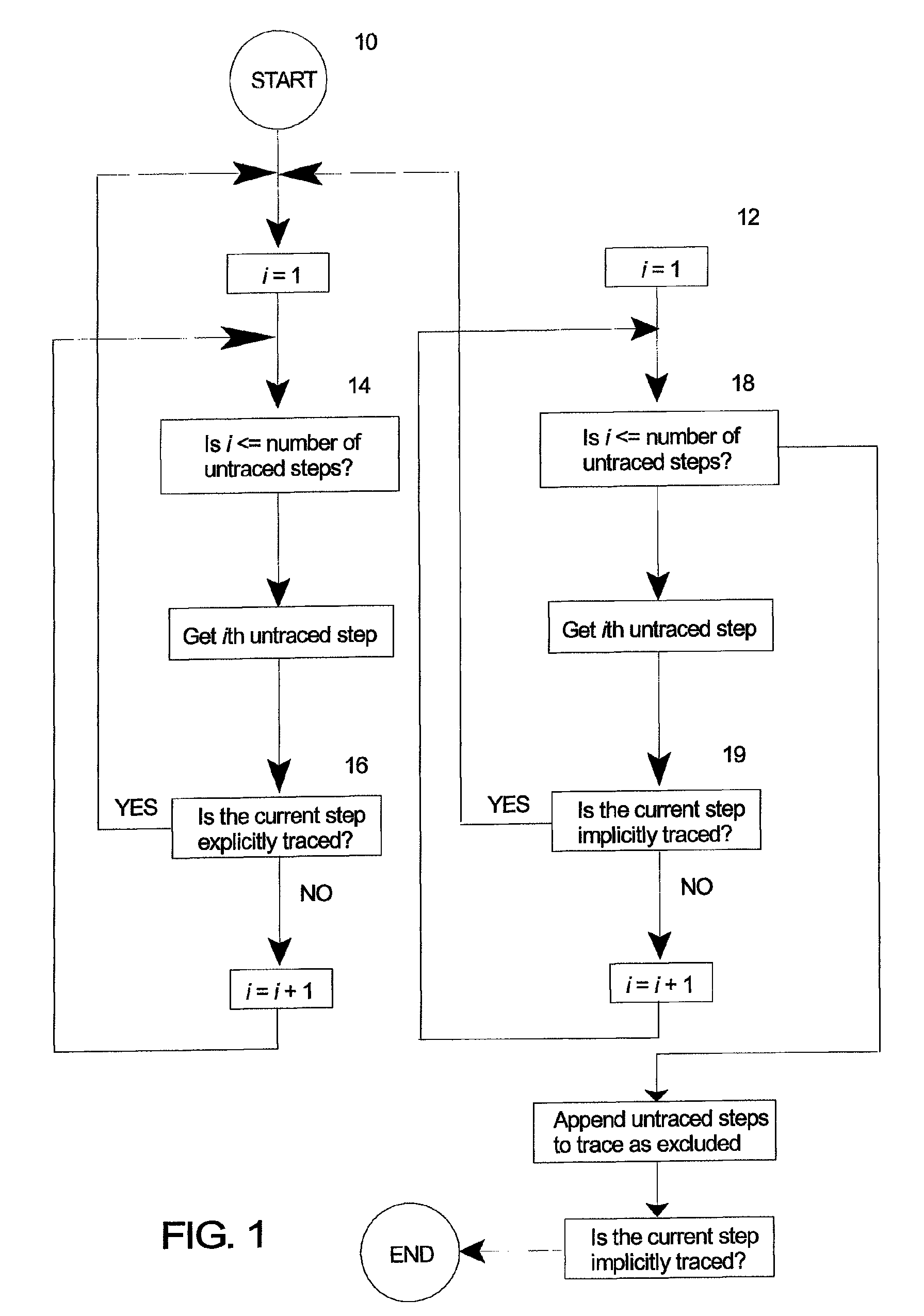Artificial intelligence software for grading of student problem-solving work
a problem-solving and problem-solving technology, applied in the field of artificial intelligence software, can solve the problems of insufficient foundation for developing the more sophisticated individualized assessment capabilities needed, the mc is a relatively blunt instrument, and teachers rarely, if ever, have time to perform such in-depth analysis. , to achieve the effect of easy interfa
- Summary
- Abstract
- Description
- Claims
- Application Information
AI Technical Summary
Benefits of technology
Problems solved by technology
Method used
Image
Examples
example 1
[0031]Is i14;
[0032]Is the current step explicitly traced? 16, then to 12 and FIG. 2;
[0033]Is i18
[0034]Is the current step implicitly traced? 19, then to FIG. 4.
[0035]In explicit tracing 10, shown in flow chart step form in FIG. 2 (detailed in source code form by FIGS. 5-7), each untraced step in the list is subjected to a series of assessments of increasing complexity, to find the simplest and clearest rationalization for the step. First, if the student's step could not be interpreted by the system 20, it cannot be considered part of the best solution path; hence the step is marked as traced and removed from further consideration 22. If the step is interpretable, it is checked against the conflict set evaluated at the problem state defined by the steps included in the best solution path so far 24. If present, this means the system was able to reproduce the student's step at the current state and the student's step is deemed a correct production 26, just as in a conventional ITS. It ...
example 2
[0036]Is the step not interpretable by the system? 20
[0037]Append the step to the trace and exclude it from the best solution path 22 (go to 27).
[0038]Can the expert system produce the step from the problem state currently defined by the best solution path? 24
[0039]Append the step to the trace and to the best solution path and mark the step as a correct production 26 (go to 27).
[0040]Is the step applicable to the problem state currently defined by the best solution path? 27a
[0041]Append the step to the trace and to the best solution path. Mark the step as not a correct production 28 (go to 27).
[0042]Does the step conflict with a previously traced step assigned to the best solution path? 23
[0043]Resolve conflict with previously traced step 25 (go to 27).
[0044]However, with reference to FIGS. 3, 8-10, steps that do not currently correspond to correct productions cannot simply be labeled as incorrect right away (as alluded above). The next case is when the student's step is not a corr...
example 3
[0045]Is the current step identical to the previously traced step? 30
[0046]Append the current step to the trace and exclude it from the best solution path 31 (end).
[0047]Is the previously traced step a correct production and the current step not a correct production when exchanged with the previous step in the best solution path? 32
[0048]Append the current step to the trace and exclude it from the best solution path 33 (end).
[0049]Is the previously traced step not a correct production and the current step a correct production when exchanged with the previous step in the best solution path? 34
[0050]Replace the previous step with the current step in the trace and best solution path. Mark the previous step and all subsequently traced steps as untraced. Mark the current step as a correct production 35 (end).
[0051]Create a copy of the current trace. On the copy replace the previous step with the current step in the trace and best solution path. Mark the previous step and all subsequently...
PUM
 Login to View More
Login to View More Abstract
Description
Claims
Application Information
 Login to View More
Login to View More - R&D
- Intellectual Property
- Life Sciences
- Materials
- Tech Scout
- Unparalleled Data Quality
- Higher Quality Content
- 60% Fewer Hallucinations
Browse by: Latest US Patents, China's latest patents, Technical Efficacy Thesaurus, Application Domain, Technology Topic, Popular Technical Reports.
© 2025 PatSnap. All rights reserved.Legal|Privacy policy|Modern Slavery Act Transparency Statement|Sitemap|About US| Contact US: help@patsnap.com



